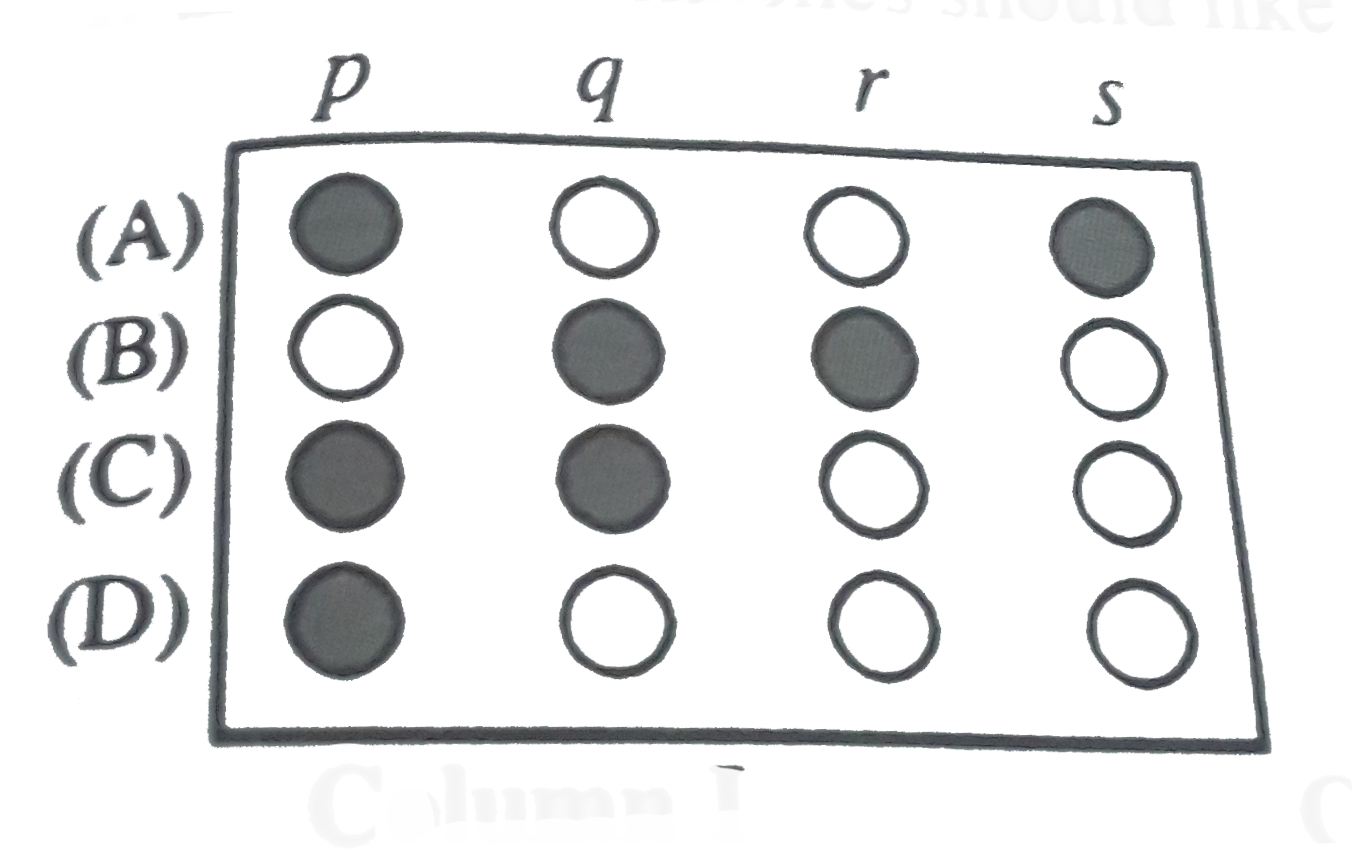COLUMN-ICOLUMN-II(Compound)(Use)(A)SO2(p)Antichlor(B)Hypo(q)reducing agent(C)Ozone(r)Purification of water(D)H2SO4(s)Dehydrating agent Solution in Telugu
The correct Answer is:A-p,q; B-p,q; C-q,r; D-s
A) SO2+2H2O→H2SO4+2[H]Reducing Agent
B) Na2S2O3+H2O+Cl2→Na2SO4+2HCl+S(antichlor)
C) H2O2+O3→2H2O+O2 - Reducing agent.
D) H2C2O4Conc.H2SO4−−−−−−−→CO2+CO+H2O,
C12H22O11Conc.H2SO4−−−−−−−→12C+11H2O - Dehydrating agent
Topper's Solved these Questions
- VIA GROUP ELEMENTSBook:AAKASH SERIESChapter:VIA GROUP ELEMENTSExercise:PRACTICE SHEET - 2 (Integer answer type Questions)
Explore 6 Videos
- VIA GROUP ELEMENTSBook:AAKASH SERIESChapter:VIA GROUP ELEMENTSExercise:PRACTICE SHEET - 3 (Single or more than one option questions)
Explore 16 Videos
- VIA GROUP ELEMENTSBook:AAKASH SERIESChapter:VIA GROUP ELEMENTSExercise:PRACTICE SHEET - 2 (Linked Comprehension type questions)
Explore 6 Videos
- VA GROUP ELEMENTSBook:AAKASH SERIESChapter:VA GROUP ELEMENTSExercise:PRACTICE EXERCISE
Explore 51 Videos
- VII GROUP ELEMENTSBook:AAKASH SERIESChapter:VII GROUP ELEMENTSExercise:OBJECTIVE EXERCISE -4
Explore 55 Videos
Similar Questions
The oxidation of naphthalene in presence of catalyst Hg/H2SO4 to Phthalicacid. How many moles of SO2 is formed ? (CO2 evolved)
View Solution100 gms of 118% oleum reacted with excess water. How much H2SO4 is formed?
View SolutionPassage-I :
When a gas 'A' is passed through dry KOH at low temperature a deep red coloured compound, B and a gas 'C' are obtained. The gas A, on reaction with but -2-ene, followed by treatment with Zn/H2O yields acetaldehyde. Identify A, B & C.
What is A
View SolutionWhich of the following reacts rapidly with oxygen in the air at ordinary temperature?
View Solution(A): The bond dissociation energy of fluorine is less than bromine.
(R): In fluorine molecule, large lone pair electronic repulsions and appreciable internuclear repulsions are present.
View SolutionIdentify:
a. The good oxidising agent (s)
b. The good reducing agent
c. The good dehydrating agent (s) among the following substances:
H2SO3,HNO3,P4O10,H2S,H2SO4.
View SolutionHere, each question contains statements given in two columns which have to be matched. Statements in column I are labelled as A,B, C, and D whereas in column II are labelled as p,q,r and s. The answers to these questions are to be appropriately bubbled as illustrated in the following example. If the correct matches are A-p, A-s, B-q, B-r, C-p, C-q and D-p, then correctly labelled 4 xx 4 matrix looks like {:(,"Column-I",,"Column-II"),("(A)",H_(2)S,p.,"Oxidising as well as reducing agent"),("(B)",SO_(2),q.,"reducing agent"),("(C)",P_(4),r.,"zero oxidation state"),("(D)",6OH^(-)+3Br_(2)rarr5Br^(-)+BrO_(3)^(-)+3H_(2)O,s.,"This proportionation in alkaline medium"):}
View SolutionHere each question contains statements given in two column which have to be matched. Statements in columns I are labelled as A, B, C and D where as the statements in column II are labelled p, q, r and s. The answers to these questions are to be appropriately bubbled as illustrated in the following example.
If the correct matches should like the following.

Column IColumn II(A)SO2(p)Basic(B)H2SO4(q)Acidic(C)HNO3(r)Reducing(D)NH3(s)Oxidizing
View SolutionMatch the entries of column I with appropriate entries of column II and choose the correct option out of the four options given. {:("Column I","Column II"),("For a 5% solution of "H_(2)SO_(4)(d ="1.01 g mL"^(-1)),),("(A) Molarity of the solution","(p) 0.537"),("(B) Molality of the solution","(q) 0.0096"),("(C) Mole fraction of "H_(2)SO_(4),"(r) 0.05"),("(D) Mass fraction of "H_(2)SO_(4),"(s) 0.515"):}
View SolutionH_(2)S acts only as a reducing agent while SO_(2) acts as an oxidising as well as a reducing agent. Why?
View SolutionMatch the entries of column I with appropriate entries of coloumn II. Each entry in column I may have one or more than one correct option from column II. If the correct matches are A-p, s , B-r, C-p, q , D-s, then the correctly bubbled 4 xx 4 matrix should be as follows : {:(,"Column I",,"Column II"),((A),SO_(2),(p),"Basic"),((B),H_(2)SO_(4),(q),"Acidic"),((C),HNO_(3),(r),"Reducing"),((D),NH_(3),(s),"Oxidising"):}
View SolutionMatch the entires of Column I with appropiate entires of column II and choose the correct option out of the four option (a) ,(b) ,(c ) (d) given at the end of each question
column Icolumn II (A)KMnO4(p)used in salt bridge(B)SnCI2(q)used as an oxidising agent(C)ZnSO4(r)used as a reducing agent(D)K2SO4(s)used as electrolyte in daniell cell
View SolutionMatch the entires of Column I with appropiate entires of column II and choose the correct option out of the four option (a) ,(b) ,(c ) (d) given at the end of each question {:(,"column I" ,, "column II "),((A) ,KMnO_(4) , (p), "used in salt bridge"),((B), SnCI_(2), (q), "used as an oxidising agent"),((C ) ,ZnSO_(4) , (r),"used as a reducing agent"),((D),K_(2)SO_(4) , (s),"used as electrolyte in daniell cell" ):}
View SolutionShow that Conc. H_(2)SO_(4) is a dehydrating agent.
View Solution(1) \(SO_{2}\) (P) Oxidizing agent
(2) \(SO_{3}\) (Q) Reducing agent
(3) \(H_{2}O_{2}\) (R) Undergoes disproportionation
(4) NaF (S) Neither an oxidizing nor a reducing agent
View SolutionH2S केवल अपचायक की तरह व्यवहार करता है जबकि SO2 अपचायक तथा ऑक्सीकारक दोनों की तरह व्यवहार करता है क्योंकि
View Solution